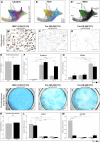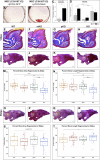Regeneration-specific promoter switching facilitates Mest expression in the mouse digit tip to modulate neutrophil response
- PMID: 39468052
- PMCID: PMC11519450
- DOI: 10.1038/s41536-024-00376-w
Regeneration-specific promoter switching facilitates Mest expression in the mouse digit tip to modulate neutrophil response
Abstract
The mouse digit tip regenerates following amputation, a process mediated by a cellularly heterogeneous blastema. We previously found the gene Mest to be highly expressed in mesenchymal cells of the blastema and a strong candidate pro-regenerative gene. We now show Mest digit expression is regeneration-specific and not upregulated in post-amputation fibrosing proximal digits. Mest homozygous knockout mice exhibit delayed bone regeneration though no phenotype is found in paternal knockout mice, inconsistent with the defined maternal genomic imprinting of Mest. We demonstrate that promoter switching, not loss of imprinting, regulates biallelic Mest expression in the blastema and does not occur during embryogenesis, indicating a regeneration-specific mechanism. Requirement for Mest expression is tied to modulating neutrophil response, as revealed by scRNAseq and FACS comparing wildtype and knockout blastemas. Collectively, the imprinted gene Mest is required for proper digit tip regeneration and its blastema expression is facilitated by promoter switching for biallelic expression.
© 2024. The Author(s).
Conflict of interest statement
The authors declare no competing interests.
Figures






Update of
-
Regeneration-specific promoter switching facilitates Mest expression in the mouse digit tip to modulate neutrophil response.bioRxiv [Preprint]. 2024 Jun 15:2024.06.12.598713. doi: 10.1101/2024.06.12.598713. bioRxiv. 2024. Update in: NPJ Regen Med. 2024 Oct 28;9(1):32. doi: 10.1038/s41536-024-00376-w. PMID: 38915675 Free PMC article. Updated. Preprint.
Similar articles
-
Regeneration-specific promoter switching facilitates Mest expression in the mouse digit tip to modulate neutrophil response.bioRxiv [Preprint]. 2024 Jun 15:2024.06.12.598713. doi: 10.1101/2024.06.12.598713. bioRxiv. 2024. Update in: NPJ Regen Med. 2024 Oct 28;9(1):32. doi: 10.1038/s41536-024-00376-w. PMID: 38915675 Free PMC article. Updated. Preprint.
-
Cellular Heterogeneity and Lineage Restriction during Mouse Digit Tip Regeneration at Single-Cell Resolution.Dev Cell. 2020 Feb 24;52(4):525-540.e5. doi: 10.1016/j.devcel.2020.01.026. Dev Cell. 2020. PMID: 32097654 Free PMC article.
-
Acquisition of a Unique Mesenchymal Precursor-like Blastema State Underlies Successful Adult Mammalian Digit Tip Regeneration.Dev Cell. 2020 Feb 24;52(4):509-524.e9. doi: 10.1016/j.devcel.2019.12.004. Epub 2020 Jan 2. Dev Cell. 2020. PMID: 31902657
-
Toeing the line between regeneration and fibrosis.Front Cell Dev Biol. 2023 Jun 1;11:1217185. doi: 10.3389/fcell.2023.1217185. eCollection 2023. Front Cell Dev Biol. 2023. PMID: 37325560 Free PMC article. Review.
-
Evolution of epimorphosis in mammals.J Exp Zool B Mol Dev Evol. 2021 Mar;336(2):165-179. doi: 10.1002/jez.b.22925. Epub 2020 Jan 17. J Exp Zool B Mol Dev Evol. 2021. PMID: 31951104 Review.
References
-
- Illingworth, C. M. Trapped fingers and amputated finger tips in children. J. Pediatr. Surg.9, 853–858 (1974). - PubMed
-
- Borgens, R. B. Mice regrow the tips of their foretoes. Science217, 747–750 (1982). - PubMed
-
- Kaneko-Ishino, T. et al. Peg1/Mest imprinted gene on chromosome 6 identified by cDNA subtraction hybridization. Nat. Genet.11, 52–59 (1995). - PubMed
Grants and funding
- F31 AR082220/AR/NIAMS NIH HHS/United States
- R01 HD109200/HD/NICHD NIH HHS/United States
- T32 AR055885/AR/NIAMS NIH HHS/United States
- DP-0205-2201/Harvard University | Harvard Stem Cell Institute (HSCI)
- F31AR082220/U.S. Department of Health & Human Services | NIH | National Institute of Arthritis and Musculoskeletal and Skin Diseases (NIAMS)
LinkOut - more resources
Full Text Sources

